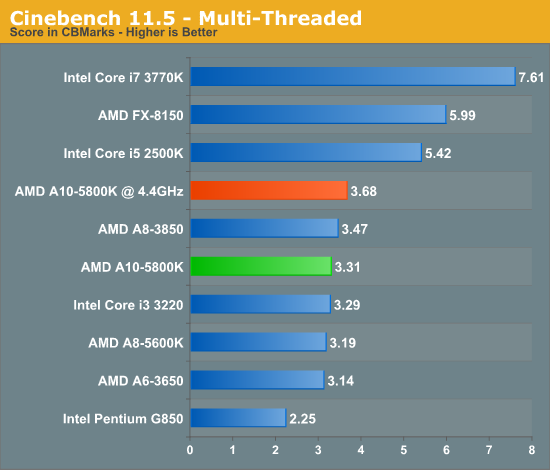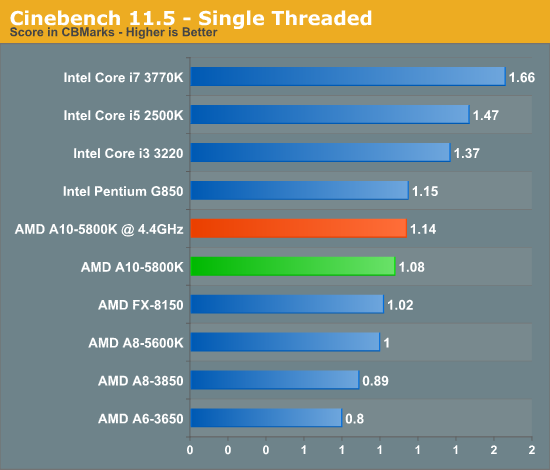AMD A10-5800K & A8-5600K Review: Trinity on the Desktop, Part 2
by Anand Lal Shimpi on October 2, 2012 1:45 AM ESTOverclocking
With Sandy Bridge Intel killed budget overclocking by completely clock locking all CPUs without turbo boost enabled. While you used to be able to buy an entry level CPU and overclock it quite nicely, Intel moved all overclocking to its higher priced parts. As a gift to the overclocking community, Intel ramped up the presence of its fully unlocked K-series parts. Anything with a K at the end shipped with a fully unlocked clock multiplier, at a small price premium. Given that Intel hadn't shipped unlocked CPUs since the days of the original Pentium, this was a welcome move on its part. What would really be nice is the addition of some lower priced K SKUs, unfortunatley we won't get that unless there's significant competitive pressure from AMD.
Trinity doesn't have what it takes to really force Intel into doing such a thing, but that doesn't mean AMD won't try. The Trinity lineup includes AMD's own K-series SKUs that, like their Intel counterparts, ship fully unlocked. From $67 all the way up to $122, AMD is offering unlocked Trinity APUs. The value of these parts really depends on just how overclockable Trinity is to begin with. The Bulldozer/Piledriver architecture is designed to push frequency, however AMD is already shipping these things at very close to 4GHz to begin with. Take AMD's turbo frequencies into account and you're already at 4.2GHz with the A10-5800K. How much additional headroom is there?

With a stock cooler and not a ton of additional voltage, it looks like there's another 5 - 15% depending on whether you're comparing base clocks or max turbo clocks. With an extra 0.125V (above the 1.45V standard core voltage setting) I was able to hit 4.4GHz on the A10-5800K. I could boot into Windows at 4.5GHz however the system wasn't stable. Although I could post at 4.6GHz, Windows was highly unstable at that frequency. With more exotic cooling I do believe I could probably make 4.5 work on the A10-5800K.

The extra frequency isn't enough to erase the single threaded performance gap between the A10 and Intel's Core i3 3220 however:

The only way AMD is going to close this gap is through a serious focus on improving single threaded performance in future architectures.










178 Comments
View All Comments
Crono - Tuesday, October 2, 2012 - link
It's good to finally see pricing on Trinity.Looks like AMD is still competitive at lower price points for Video transcoding performance, which is good news for me and others who's highest CPU workloads are mostly video editing.
But even for gaming the A10-5800/K doesn't look too bad for $122 chips.
Glad to see it isn't quite "Bulldozer" all over again. I need to build a new system for Windows 8 and Trinity looks promising for a budget to mid range build.
ac2 - Tuesday, October 2, 2012 - link
Big deal...Just look at pg 2, the single threaded performance of the A10 is lower than a friggin Pentium G850
Pg 3 Sysmark, only slightly ahead of the Pentium even with 2 additional Integer cores
I wish Anand had included the Pentium G850 power comparison as well though at 65W vs 100W TDP we can be sure which way that will swing...
And the G850 costs a little more than HALF the A10 suggested price... That puts a $70 saving towards a discrete graphics card, which, as per pg 6 should result in a much better gaming performance as well...
StevoLincolnite - Tuesday, October 2, 2012 - link
It's also slower than an old Core 2 Quad Q6600 overclocked to 3.6ghz+ which was released in 2007 both in single threaded and multi-threaded tasks.However, what I would like to see is some under-volting tests to see how low they can go in terms of TDP as AMD has always been incredibly conservative (Even on the GPU side) with voltages, would be excellent in a Mini-ITX rig without the need for a dedicated GPU.
MrMilli - Tuesday, October 2, 2012 - link
http://www.computerbase.de/artikel/prozessoren/201...Belard - Tuesday, October 2, 2012 - link
Really cool how the performance charts are NOT static.Ah, German technology. :)
phillock - Friday, January 26, 2018 - link
I think there is very little need for raw single-threaded performance increases in consumer-level "general computation" processors (e.g. few-core x86 processors). So who cares if we don't have a second intel? What we do need are better ways of extracting performance from multiple cores, and from the massively parallel architectures found in GPUs. Part of the equation is ensuring that these two paradigms are pervasive, and therefore,https://audiomanagerapp.wordpress.com/2017/10/11/a... from a big-picture point-of-view, AMD really *is* pushing things forward with TrinityB3an - Tuesday, October 2, 2012 - link
Trinity truly is embarrassingly slow. I think it should be even cheaper for this performance level. And it's also disappointing that Intel have no performance competition AT ALL from AMD. We need this for some real progression to be made in desktop CPU's and also drive prices down at the high end.IKeelU - Tuesday, October 2, 2012 - link
What kind of progress are you talking about? Power efficiency? Raw general computing performance? Progress comes in many forms.I think there is very little need for raw single-threaded performance increases in consumer-level "general computation" processors (e.g. few-core x86 processors). So who cares if we don't have a second intel? What we do need are better ways of extracting performance from multiple cores, and from the massively parallel architectures found in GPUs. Part of the equation is ensuring that these two paradigms are pervasive, and therefore, from a big-picture point-of-view, AMD really *is* pushing things forward with Trinity.
Belard - Tuesday, October 2, 2012 - link
AMD's progress is about 2 years behind. While this is somewhat intel's fault by illegal competitive practices which in turn kept AMD from profiting as much as they could have during the Athlon64~X2 era.AMD has done a lot of things wrong and would take at least 2 years to sort out... if ever. FM2 is no better than FM1 and not cross compatible. Neither is compatible with Socket AM3 and nothing AMD has on the market even supports PCIe 3.0.
Compared to buying an intel i3-something system, in which you can upgrade to an i7-something easily. AMD has a mess on their hands and I suspect part of their performance problems could also be rooted in their chipsets. (Across the board, the performance hits a wall). Yeah, for a notebook - the powerful GPU part comes into play. And both intel i3 and Trinity is more than powerful enough for MOST people. hell, I'm still running on a Q6600 at 2.4Ghz and it does quite well (going i5-3570 this weekend)... But for those who want their money's worth when performance counts, AMD is not in the game.
The performance from AMD has to be consistent, and its not. The heat is not good along with the cheap fans they include that are noisy and should be replaced with a good $20~50 cooler. Meanwhile intel CPUs are running cooler and their fans are very quiet.
So as of today, in general - it costs more to get an AMD. I really want AMD to do well, I've sold lots of AMD systems in the past.
Origin64 - Wednesday, October 3, 2012 - link
About PCIe 3.0, nobody needs that. 2.0 * 8 is enough to drive every card on the market with maybe 2% performance loss, which is within the error margin of every benchmark. To keep prices low, of course they're not going to add extra features that nobody needs. I think it's a smart move.Other than that, I agree. AMD hasn't been doing well price-performance wise the last two years. I have a Phenom II, and when they were released they were still competitive, for the price and the time, but the last two generations have seen no singlethreaded performance increase and cost about the same.